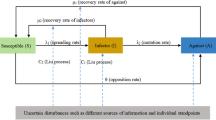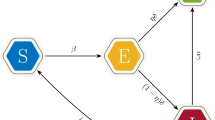Abstract
In this work we propose a novel and alternative interpretation of the SEIR model, typically used in epidemiology to describe the spread of a disease in a given population, to describe the diffusion of fake information on the web and the consequent truth re-affirmation. We describe the corresponding system of ordinary differential equations, giving a proper definition of the involved parameters and, through a local linearization of the system, we calculate the so-called stiffness ratio, i.e. the ratio between the real parts of the largest and smallest eigenvalues of the Jacobian matrix of the linearized problem. A large gap in the spectrum of such a Jacobian matrix (i.e., a large stiffness ratio) makes the underlying differential problem stiff. So, we study and analyze the stiffness index of the SEIR model and, through selected numerical examples on real datasets, we show that the more the model is stiff, the faster is the transit of fake information in a given population.
Access this chapter
Tax calculation will be finalised at checkout
Purchases are for personal use only
Similar content being viewed by others
References
ITU Committed to connecting the world. https://www.itu.int/en/ITU-D/Statistics/Pages/stat/default.aspx. Accessed 31 Mar 2022
World Bank Open Data. https://data.worldbank.org/. Accessed 31 Mar 2022
Ansumali, S., Kaushal, S., Kumar, A., Prakash, M., Vidyasagar, M.: Modelling a pandemic with asymptomatic patients, impact of lockdown and herd immunity, with applications to SARS-CoV-2. Annu. Rev. Control. 50, 432–447 (2020). https://doi.org/10.1016/j.arcontrol.2020.10.003
Antonelli, E., Piccolomini, E., Zama, F.: Switched forced SEIRDV compartmental models to monitor COVID-19 spread and immunization in Italy. Infect. Dis. Model. 7, 1–15 (2022). https://doi.org/10.1016/j.idm.2021.11.001
Berduygina, O., Vladimirova, T., Chernyaeva, E.: Trends in the spread of fake news in mass media. Media Watch 10(1), 122–132 (2019). https://doi.org/10.15655/mw/2019/v10i1/49561
Brauer, F., Castillo-Chavez, C.: Mathematical Models in Population Biology and Epidemiology. TAM, vol. 40. Springer, New York (2012). https://doi.org/10.1007/978-1-4614-1686-9
Brauer, F., van de Driessche, P., Wu, J.: Mathematical Epidemiology. Springer, Heidelberg (2008). https://doi.org/10.1007/978-3-540-78911-6
Brody, D., Meier, D.: How to model fake news. arXiv arXiv:1809.00964 (2018)
Calvetti, D., Hoover, A., Rose, J., Somersalo, E.: Metapopulation network models for understanding, predicting, and managing the coronavirus disease COVID-19. Front. Phys. 8 (2020). https://doi.org/10.3389/fphy.2020.00261
Chowell, G.: Fitting dynamic models to epidemic outbreaks with quantified uncertainty: a primer for parameter uncertainty, identifiability, and forecasts. Infect. Dis. Model. 2, 379–398 (2017). https://doi.org/10.1016/j.idm.2017.08.001
Conte, D., D’Ambrosio, R., Paternoster, B.: Improved theta-methods for stochastic Volterra integral equations. Commun. Nonlinear Sci. Numer. Simul. 93 (2021). https://doi.org/10.1016/j.cnsns.2020.105528. Article no. 105528
D’Ambrosio, R., Giordano, G., Mottola, S., Paternoster, B.: Stiffness analysis to predict the spread out of fake news. Future Internet 13, 222 (2021). https://doi.org/10.3309/fi13090222
D’Ambrosio, R., Moccaldi, M., Paternoster, B.: Adapted numerical methods for advection-reaction-diffusion problems generating periodic wavefronts. Comput. Math. Appl. 74(5), 1029–1042 (2017). https://doi.org/10.1016/j.camwa.2017.04.023
D’Ambrosio, R., Paternoster, B.: Multivalue collocation methods free from order reduction. J. Comput. Appl. Math. 387 (2021). https://doi.org/10.1016/j.cam.2019.112515. Article no. 112515
Dentith, M.: The problem of fake news. Public Reason 8(1–2), 65–79 (2016)
Dong, S., Deng, Y., Huang, Y.: SEIR model of rumor spreading in online social network with varying total population size. Commun. Theor. Phys. 68, 545–552 (2017). https://doi.org/10.1088/0253-6102/68/4/545
D’Ulizia, A., Caschera, M., Ferri, F., Grifoni, P.: Fake news detection: a survey of evaluation datasets. PeerJ Comput. Sci. 7, e518 (2021). https://doi.org/10.7717/peerj-cs.518
Franceschi, J., Pareschi, L.: Spreading of fake news, competence, and learning: kinetic modeling and numerical approximation. arXiv arXiv:2109.14087 (2021)
Giordano, G., Mottola, S., Paternoster, B.: A short review of some mathematical methods to detect fake news. Int. J. Circuits Syst. Signal Process. 14, 255–265 (2020). https://doi.org/10.46300/9106.2020.14.37
Godio, A., Pace, F., Vergnano, A.: SEIR modeling of the Italian epidemic of SARS-CoV-2 using computational swarm intelligence. Int. J. Environ. Res. Public Health 17(10), 3535 (2020). https://doi.org/10.3390/ijerph17103535
Gopal, R., Chandrasekar, V.K., Lakshmanan, M.: Analysis-of-the-second-wave-of-Covid19-in-India-based-on-SEIR-model. Eur. Phys. J. (2022). https://doi.org/10.1140/epjs/s11734-022-00426-8
Guo, B., Ding, Y., Sun, Y., Ma, S., Li, K., Yu, Z.: The mass, fake news, and cognition security. Front. Comp. Sci. 15(3), 1–13 (2020). https://doi.org/10.1007/s11704-020-9256-0
Guo, B., Ding, Y., Yao, L., Liang, Y., Yu, Z.: The future of false information detection on social media: new perspectives and trends. ACM Comput. Surv. 53(4) (2020). https://doi.org/10.1145/3393880. Article no. 3393880
Inthamoussou, F.A., Valenciaga, F., Núñez, S., Garelli, F.: Extended SEIR model for health policies assessment against the COVID-19 pandemic: the case of Argentina. J. Healthcare Inform. Res. 6(1), 91–111 (2021). https://doi.org/10.1007/s41666-021-00110-x
Iwata, K., Miyakoshi, C.: A simulation on potential secondary spread of novel coronavirus in an exported country using a stochastic epidemic SEIR model. J. Clin. Med. 944(9) (2020). https://doi.org/10.3390/jcm9040944
Kapantai, E., Christopoulou, A., Berberidis, C., Peristeras, V.: A systematic literature review on disinformation: toward a unified taxonomical framework. New Media Soc. 23(5), 1301–1326 (2021). https://doi.org/10.1177/1461444820959296
Kelly, D.: Evaluating the news: (mis)perceptions of objectivity and credibility. Polit. Behav. 41(2), 445–471 (2018). https://doi.org/10.1007/s11109-018-9458-4
Kendall, D.G.: Deterministic and Stochastic Epidemics in Closed Populations, pp. 149–166. University of California Press (2020). https://doi.org/10.1525/9780520350717-011
Kermack, W.O., McKendrick, A.G.: A contribution to the mathematical theory of epidemics. Proc. R. Soc. A 115, 700–721 (1927). https://doi.org/10.1098/rspa.1927.0118
Khurana, P., Kumar, D.: Sir model for fake news spreading through Whatsapp. In: Proceedings of 3rd International Conference on Internet of Things and Connected Technologies (2018). https://doi.org/10.2139/ssrn.3166095
Lambert, J.: Numerical Methods for Ordinary Differential Systems. Wiley, New York (1992)
Mahmoud, H.: A model for the spreading of fake news. J. Appl. Probab. 57(1), 332–342 (2020). https://doi.org/10.1017/jpr.2019.103
Murayama, T.: Dataset of fake news detection and fact verification: a survey. arXiv https://arxiv.org/pdf/2111.03299.pdf (2021)
Murayama, T., Wakamiya, S., Aramaki, E., Kobayashi, R.: Modeling the spread of fake news on Twitter. PLoS ONE 16(4), e0250419 (2021). https://doi.org/10.1371/journal.pone.0250419
O’Connor, C., Weatherall, J.: The Misinformation Age: How False Beliefs Spread. Yale University Press, London (2019)
Peng, L., Yang, W., Zhang, D., Zhuge, C., Hong, L.: Epidemic analysis of COVID-19 in China by dynamical modeling (2020). https://www.medrxiv.org/content/10.1101/2020.02.16.20023465v1
Pengpeng, S., Shengli, C., Peihua, F.: SEIR transmission dynamics model of 2019 nCoV coronavirus with considering the weak infectious ability and changes in latency duration (2020). https://doi.org/10.1101/2020.02.16.20023655
Rider, S., Peters, M.A.: Post-truth, fake news: viral modernity and higher education. In: Peters, M.A., Rider, S., Hyvönen, M., Besley, T. (eds.) Post-Truth, Fake News, pp. 3–12. Springer, Singapore (2018). https://doi.org/10.1007/978-981-10-8013-5_1
Piccolomini, E., Zama, F.: Monitoring Italian COVID-19 spread by a forced SEIRD model. PLoS ONE 15(8), e0237417 (2020). https://doi.org/10.1371/journal.pone.0237417
Reyes-Menendez, A., Saura, J., Filipe, F.: The importance of behavioral data to identify online fake reviews for tourism businesses: a systematic review. PeerJ Comput. Sci. 5, e219 (2019). https://doi.org/10.7717/peerj-cs.219
Robinson, M., Stilianakis, N.: A model for the emergence of drug resistance in the presence of asymptomatic infections. Math. Biosci. 243, 163–177 (2013). https://doi.org/10.1016/j.mbs.2013.03.003
Ross, R.: An application of the theory of probabilities to the study of a priori pathometry.-Part I. Proc. R. Soc. A A92, 204–230 (1916). https://doi.org/10.1098/rspa.1916.0007
Ross, R., Hudson, H.: An application of the theory of probabilities to the study of a priori pathometry.- Part II. Proc. R. Soc. A A93, 212–225 (1917). https://doi.org/10.1098/rspa.1917.0014
Ross, R., Hudson, H.: An application of the theory of probabilities to the study of a priori pathometry.- Part III. Proc. R. Soc. A A93, 225–240 (1917). https://doi.org/10.1098/rspa.1917.0015
Savi, P., Savi, M., Borges, B.: A mathematical description of the dynamics of coronavirus disease 2019 (COVID-19): a case study of Brazil. Comput. Math. Methods Med. (2020). https://doi.org/10.1155/2020/9017157
Shin, J., Jian, L., Driscoll, K., Bar, F.: The diffusion of misinformation on social media: temporal pattern, message, and source. Comput. Hum. Behav. 83, 278–287 (2018). https://doi.org/10.1016/j.chb.2018.02.008
Tandoc, E.: The facts of fake news: a research review. Sociol. Compass 13(9) (2019). https://doi.org/10.1111/soc4.12724. Article no. e12724
Tandoc, E., Lim, D., Ling, R.: Diffusion of disinformation: how social media users respond to fake news and why. Journalism 21(3), 381–398 (2020). https://doi.org/10.1177/1464884919868325
Youssef, H., Alghamdi, N., Ezzat, M., El-Bary, A., Shawky, A.: A new dynamical modeling SEIR with global analysis applied to the real data of spreading COVID-19 in Saudi Arabia. Math. Biosci. Eng. 17, 7018–7044 (2020). https://doi.org/10.3934/mbe.2020362
Zannettou, S., Sirivianos, M., Blackburn, J., Kourtellis, N.: The web of false information: rumors, fake news, hoaxes, clickbait, and various other shenanigans. J. Data Inf. Qual. 11(3) (2019). https://doi.org/10.1145/3309699. Article no. 10
Zhang, J., Jianquan, L., Zhien, M.: Global dynamics of an SEIR epidemic model with immigration of different compartments. Acta Mathematica Scientia 26B(3), 551–567 (2006)
Zhang, X., Ghorbani, A.: An overview of online fake news: characterization, detection, and discussion. Inf. Process. Manag. 57(2) (2020). https://doi.org/10.1016/j.ipm.2019.03.004. Article no. 102025
Zhou, X., Zafarani, R.: A survey of fake news: fundamental theories, detection methods, and opportunities. ACM Comput. Surv. 53, 40 (2020). https://doi.org/10.1145/3395046
Acknowledgements
The authors are members of the GNCS group. This work was supported by GNCS-INDAM project, and by the Italian Ministry of University and Research (MUR) through the PRIN 2020 project (No. 2020JLWP23) “Integrated Mathematical Approaches to Socio-Epidemiological Dynamics” (CUP: E15F21005420006) and through the PRIN 2017 project (No. 2017JYCLSF) “Structure preserving approximation of evolutionary problems”. Patricia Díaz de Alba gratefully acknowledges Fondo Sociale Europeo REACT EU - Programma Operativo Nazionale Ricerca e Innovazione 2014–2020 and Ministero dell’Università e della Ricerca for the financial support.
Author information
Authors and Affiliations
Corresponding author
Editor information
Editors and Affiliations
Rights and permissions
Copyright information
© 2022 The Author(s), under exclusive license to Springer Nature Switzerland AG
About this paper
Cite this paper
D’Ambrosio, R., Díaz de Alba, P., Giordano, G., Paternoster, B. (2022). A Modified SEIR Model: Stiffness Analysis and Application to the Diffusion of Fake News. In: Gervasi, O., Murgante, B., Hendrix, E.M.T., Taniar, D., Apduhan, B.O. (eds) Computational Science and Its Applications – ICCSA 2022. ICCSA 2022. Lecture Notes in Computer Science, vol 13375. Springer, Cham. https://doi.org/10.1007/978-3-031-10522-7_7
Download citation
DOI: https://doi.org/10.1007/978-3-031-10522-7_7
Published:
Publisher Name: Springer, Cham
Print ISBN: 978-3-031-10521-0
Online ISBN: 978-3-031-10522-7
eBook Packages: Computer ScienceComputer Science (R0)




